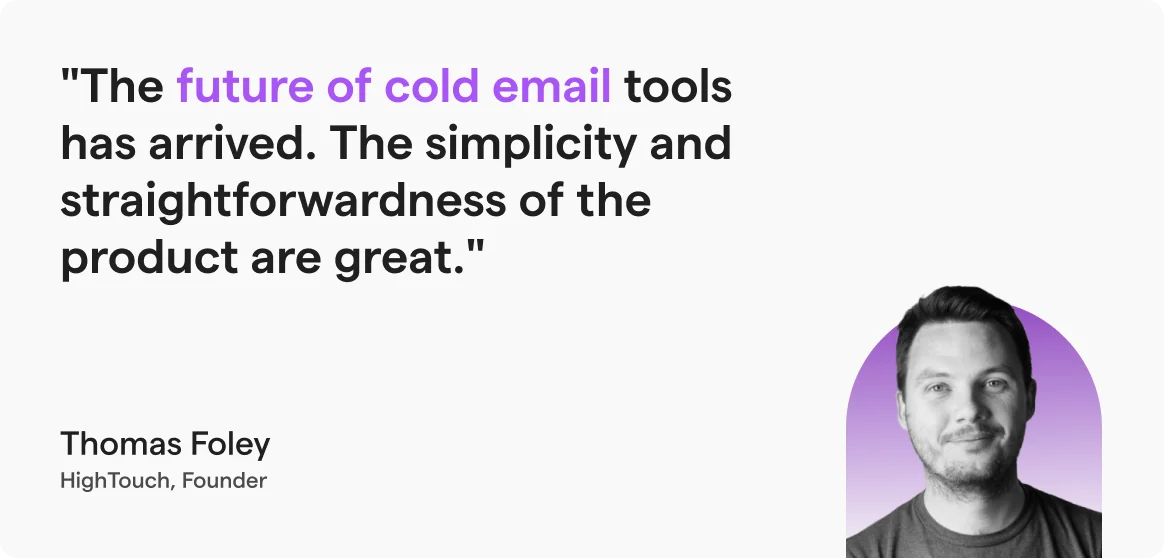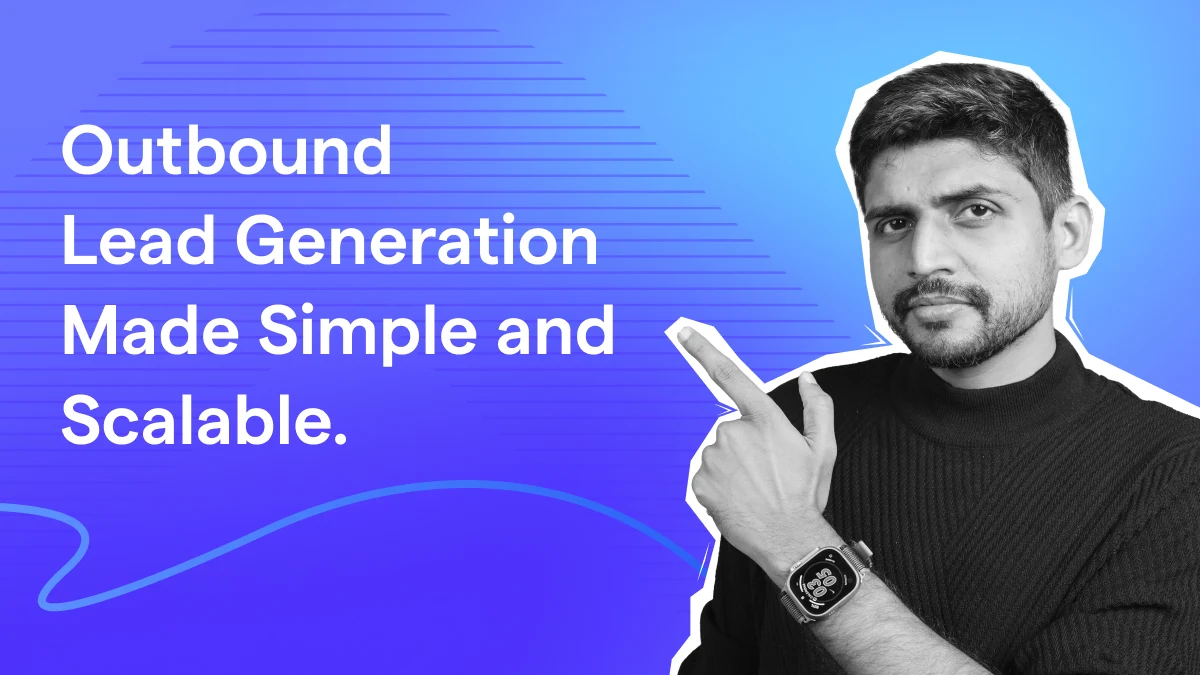Contents
- 1 Outbound Lead Generation: TOC
- 2 What is Outbound Lead Generation?
- 3 9 Proven Outbound Lead Generation Strategies That Work in 2025
- 4 Outbound Lead Generation Process For High Conversion
- 5 Emerging Technologies Powering Outbound Lead Generation in 2025
- 6 Key Takeaways
- 7 FAQs: Outbound Lead Generation
- 7.1 1. What Is Outbound Lead Generation?
- 7.2 2. Inbound vs Outbound Lead Gen: Which One Is Better?
- 7.3 3. Why Is Outbound Lead Generation Good for Your Brand?
- 7.4 4. What are the Key Tasks in an Outbound Lead Gen Campaign?
- 7.5 5. What’s the Difference Between Inbound and Outbound Leads?
- 7.6 6. Do Outbound Lead Gen Services Work Globally?
A few years ago, I found myself staring at a blank screen like you, trying to figure out how to generate leads without spending a fortune on ads or waiting months for SEO to take effect.
So I read and learnt about outbound.
Cold emails. LinkedIn DMs. It wasn’t perfect at first, but it worked.
I started seeing replies. Then booked meetings. Then built a pipeline that moved. (It took some time, nothing was overnight.)
Since then, I’ve helped dozens of teams, from solo founders to growing sales teams, build outbound systems that generate consistent leads.
If you’re wondering what outbound lead generation really means today, how to do it without sounding spammy, or how to scale it in a way that doesn’t burn out your team, this guide is for you.
I’ll walk you through what outbound is, 9 proven strategies that are working right now, and how to use tools and tech (like AI) to save hours and get better results.
Let’s get into it.
Outbound Lead Generation: TOC
What is Outbound Lead Generation?
Outbound lead generation is when you reach out to potential customers instead of waiting for them to come to you.
It’s like knocking on the door (digitally) to introduce your product or service.
This usually happens through;
- Cold emails
- LinkedIn messages
- Cold calls
- Direct outreach on social media
The goal is to start conversations, build interest, and turn those leads into paying customers.
It’s the opposite of inbound, where people find you through SEO, ads, or blogs.
However, before reaching out, it’s essential to identify who you consider your potential customers or an ideal outbound lead.
Let’s learn that.
What is an Outbound Lead?
An outbound lead is someone your sales team reaches out to when they show buying signals, or they simply fit the type of ICP you have defined for your business or brand.
Does that mean sales reps have to reach out to all the leads that show some signals?
No!
They go in too fast, too wide, and when it doesn’t work, they blame the channel.
The truth is that outbound works when you reach out to the right leads at the right time.
To do that, you need a lead qualification system.
What is Outbound Lead Qualification? Understand Fit vs Intent
Outbound lead qualification is the process of deciding which leads are worth reaching out to and which ones aren’t.
Instead of blindly contacting everyone, you score or filter leads based on specific criteria.
This helps you focus on high-potential prospects and avoid wasting time.
To keep things simple:
- Fit means they look like the right customer.
- Intent means they’re showing buying interest.
Example:
- Basic Fit Lead: This is based on things like;
Job title
Industry
Company size, location, tech stack, etc.
Example: A CTO at a software company = Good Fit! - Intent Fit Lead: This is all about behaviour. Not who they are but what they do.
Opened or clicked your email
Visited your website
Engaged with your LinkedIn profile
Example: CTO at a software company who just opened your cold email = Good Fit + High Intent!
Who Does Outbound Lead Generation?
Sales teams: SDRs (Sales Development Reps) reach out to leads, while BDMs (Business Development Managers) handle advanced conversations.
Marketing teams: Performance marketers run ads, while content marketers create cold emails, blogs, or LinkedIn messaging sequences.
Together, they identify leads and move them further down the sales funnel.
9 Proven Outbound Lead Generation Strategies That Work in 2025
This section isn’t just theory.
These are the same outbound lead generation techniques I’ve used to help founders, sales reps, and agencies build repeatable outbound lead generation systems.
- Cold Emails
- LinkedIn Outreach
- Cold Calling
- Multi-Channel Outreach
- Social Selling
- Pay Per Click
- Partner and Affiliate
- Webinars and Events
- Content Syndication
Let’s start with the best!
1. Cold Emailing
Who’s It For?
Businesses seeking a fast, scalable, fully automated, and cost-effective method for outbound lead generation.
Cold emailing dominates outbound lead generation in 2025.
Why so?
Because compared to other channels, it’s easy to start, can be done without having a big team, and even today, emails remain the preferred communication channel for business.
But what separates basic cold email from advanced is the tool you use.
Sales teams today swear on AI-assisted tools like Saleshandy to turn cold emails into a powerful, repeatable outbound lead generation system.

Here’s what Saleshandy offers:
- 98% Inbox deliveries of your cold emails: Supported by a complete email deliverability suite. That means no spam, blacklists, or bounced emails.
- Hyper-personalized and spam-proof emails using features like AI content variants, follow-ups with targeted outreach emails, content guide, and personalization tags like Merge tags, Spintax, and Variable tags.
- An email tracking system to know exactly what works by analyzing key metrics like clicks, opens, and more.
Additionally, Saleshandy features its own lead finder, which includes a B2B lead database of over 700M+ global contacts.

If finding leads or lacking knowledge of cold emailing is holding you back from reaching your targets, consider giving Saleshandy a try! (It comes with a 7-day free trial)
2. LinkedIn Prospecting
Who’s It For?
Businesses selling high-trust, high-ticket B2B offers, like consulting, coaching, or complex services.
If your product or service requires explanation, credibility, or a relationship before closing the deal, LinkedIn is where you start.
- It’s easy to find decision-makers across different industries.
- More importantly, LinkedIn is designed for professional conversations, making it a natural space for outreach.
- It’s the best platform for relationship-based selling, especially when trust is the main driver.
LinkedIn is ideal for,
- Businesses whose offer isn’t easy to explain in one sentence, and benefits from social proof.
- Companies that benefit from industrial and topical authority, where brand awareness and visibility matter.
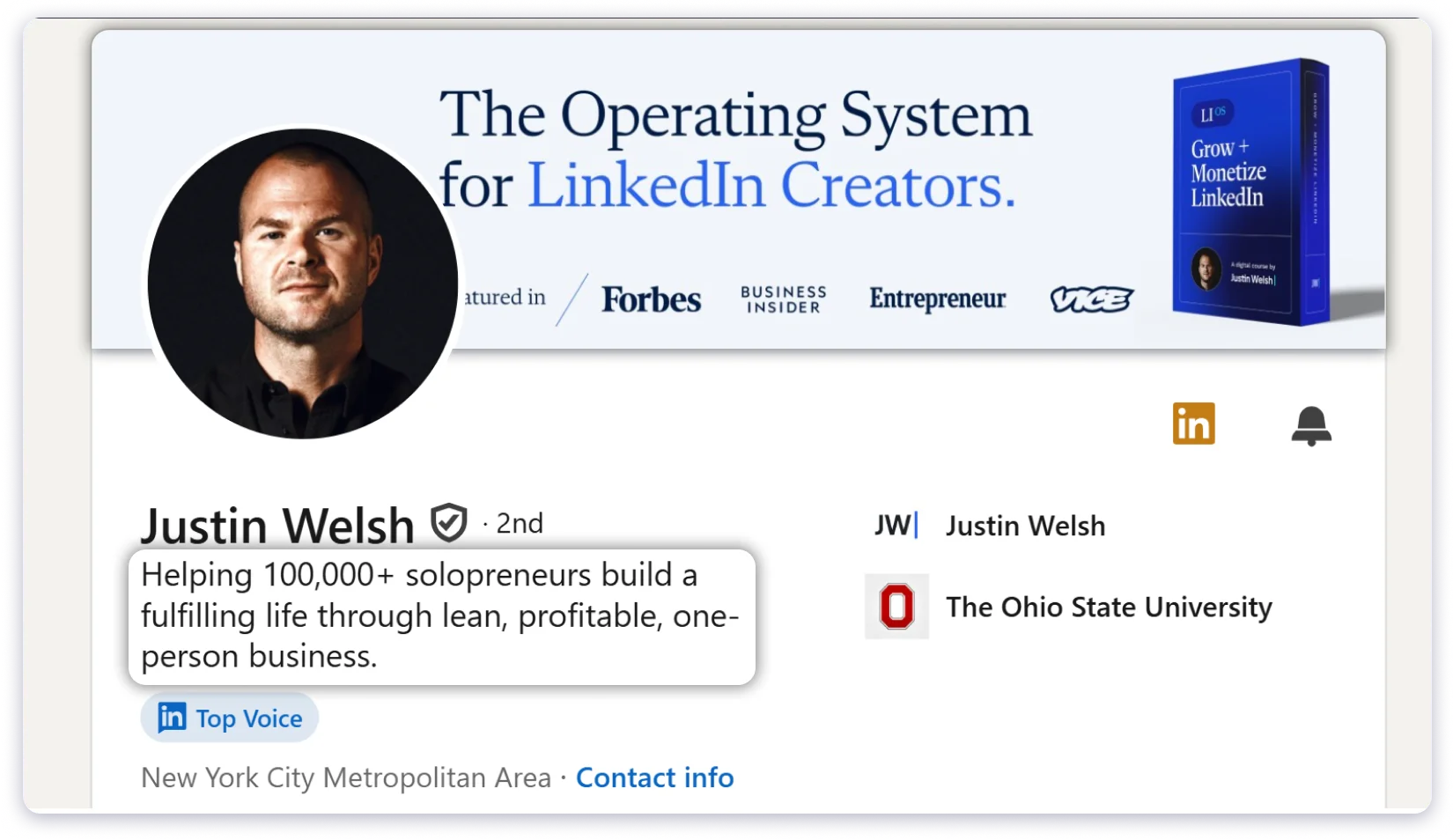
How to Get Started with LinkedIn?
You just need three things,
- Strong and clear profile: Your banner, headline, and ‘about’ section should clearly say who you help and how.
- Well-defined ICPs: Use LinkedIn Sales Navigator or free filters to find your ideal titles in your target industry.
- Personalised, natural outreach – Send a short, relevant connection note—no pitch. Engage with their content by liking or commenting where it makes sense. After 2–3 days, follow up with a value-led DM, not a sales message.
A single person can send 20–30 personalized connection requests per day and start 5–10 meaningful conversations per week.
An example DM of a B2B website design service:
⚠️ Heads-up:
LinkedIn is slower than cold email, but way more personal. Think of it as your nurture channel. Use it well, and it builds trust that supports your email efforts.
If LinkedIn feels like the right channel, check this LinkedIn Prospecting Guide to learn it in depth.
3. Cold Calling
Who’s It For?
Businesses solving urgent problems or selling high-ticket offers that require trust and fast decisions.
Cold calling gives you something most other channels don’t: Immediate answers. You’ll know in seconds whether someone is in or out.
That’s why it works so well in industries like:
- Staffing & recruitment
- IT support
- Logistics
- Local B2B services
If your product needs a 1:1 conversation to build trust, and you can confidently explain the value in 30 seconds, cold calling is a great fit.
Why Cold Calling Still Works in 2025:
You’re not lost in someone’s inbox—you’re in their ear.
It’s personal, direct, and hard to ignore.
You receive real-time objections (or interest), which helps you refine your pitch quickly.
But here’s the thing: It works best when it’s not a cold call anymore.
Start with a cold email 1–2 days before. That way, when you call, you’re following up, not interrupting.
How to Build Your Cold Calling System:
- Start with a focused list. 30–50 high-fit contacts per sprint.
- Send a cold email first. Track opens and clicks.
- Call only those who engage. You’re now calling warm leads, not ice-cold ones.
- Use a 10–15 second opener. Provide value, context, and ask permission.
- Drop a voicemail or follow up on LinkedIn if they don’t pick up.
Example Opener:
“Hi {{First Name}}, this is John. I sent you an email about improving your website bookings a few days ago. Just checking in to see if it made sense to discuss?”
No over-promising. No forceful sales, just a genuine ask to provide something helpful.
Although cold calling is one of the least scalable methods, it’s also one of the highest ROI providing if you perfect timing and pitch.
That means you might only get 5–10 connections per day, but each one is worth five LinkedIn DMs if done right.
Can’t find the phone number of your leads? Check this guide on finding phone numbers easily.
Pro Tip: Use cold calling for follow-ups, connecting with high-intent leads, or high-value deals.
4. Multi-Channel Outreach
Who’s It For?
Businesses in crowded markets or targeting busy decision-makers who don’t stick to one platform.
Let’s be honest—most people don’t reply to your first email or call.
They’re scrolling LinkedIn, checking emails, and missing voicemails. That’s just how buying works now.
That’s why multi-channel outreach works so well.
It gives you more chances to be seen, builds familiarity, and boosts reply rates.
What is Multi-Channel Outreach?
It’s a mix of:
- Cold emails
- LinkedIn outreach
- Cold calls (on warm leads)
This combo builds momentum. Each touchpoint warms them up for the next.
👉 It typically takes 3+ follow-ups across different channels before you get a reply.
And no, you don’t need a huge budget to do this.
Even something as simple as LinkedIn + cold email can move the needle fast.
Multi-Channel System (Low Budget-Friendly):
- Build a solid lead list
- Make sure your ICP is clear and refined
- Start with a personalized cold email
- Use something short, specific, and relevant
- Send a LinkedIn connection request
- Do this right after your email lands
- No reply? Send a short LinkedIn DM. Keep it casual and value-first, not pitchy
- Still nothing? Call only your warm or high-priority leads
Why It Works:
- You’re no longer just “some random person who emailed them once.”
- You’re now a name they’ve seen, a face on LinkedIn, and a real human who followed up.
Follow-ups across channels can boost reply rates by up to 28%.
Because the more familiar you are, the easier it is for them to trust and respond.
5. Social Selling
Who’s It For?
Businesses that heavily rely on their brand image. Businesses in industries like education or technical products.
What is social selling?
It’s not about spamming your feed with offers.
It’s about showing up, being helpful, and letting people come to you when they’re ready.
You’re building relationships—not just pipelines.
Over time, this creates leads who already understand your value before you send the first DM or cold email.
Here are a few things you can try in social selling.
- Post helpful content regularly, like tips, case studies, and industry insights.
- Host LinkedIn events, reply in groups, and participate in industry trends.
- Identify and engage with your ICPs. Genuinely comment on their posts.
- Respond to comments and messages promptly to nurture connections.
- Share success stories or client wins without heavy selling.
💡 Pro Tip: Use social selling as a pre-warm layer before cold outreach. It raises awareness and trust, so your emails and calls land better.
6. Pay-Per-Click Ads
Who’s It For?
Businesses that have specific offers or competitive advantages. Those with medium to high budgets.
PPC is a great way to generate leads fast, experiment with messaging, and support your other outbound efforts.
With PPC, you can quickly show your offer or solutions to targeted audiences on platforms like Google, LinkedIn, or Facebook.
When It Works Best
- You have a clear, compelling offer
- You want to scale fast or test messaging
- You’re pairing it with email or sales follow-ups
- You can invest in landing pages and tracking tools
Here are a few things that can help elevate results from your PPC campaign,
- Design a focused landing page tailored to your offer.
- Target ads to your ICP using job titles or keywords related to intent.
- Capture leads through a form or calendar scheduler like Calendly.
- Reach out to these leads with cold emails using Saleshandy.
- Analyse PPC results to see which messages perform best.
While PPC can accelerate lead generation, keep a close eye on the cost per lead and conversions to prevent overspending.
Here are two main mistakes to avoid overspending.
- Don’t direct cold traffic to a generic homepage.
- Make sure your ads have a clear call to action.
Remember: Leads from PPC still need follow-up and nurturing. By pairing PPC with automated email follow-ups, you create a steady pipeline of warm prospects.
7. Partner and Affiliate Referrals
Who’s It For?
Teams with a solid network, strong product-market fit, and the bandwidth to handle warm leads, especially in industries with complementary solutions (think: SaaS, services, tech, or tools).
Partnering with affiliates or businesses opens access to pre-warmed audiences who already trust your partners..
This approach is cost-effective and often produces high-quality leads because referrals come with built-in credibility.
This works well if you :
- Collaborate with complementary markets or products
- Want to grow faster without increasing the outbound workload
- Prefer warm leads who are already somewhat qualified
To get started, follow these four steps:
- Identify potential partners whose customers might need your services
- Propose mutually beneficial deals, like commissions or joint webinars
- Provide partners with clear messaging and materials for easy promotion
- Track referrals carefully to reward performance and optimise partnerships
Referral partnerships can quietly be your best-performing channel—no ad budget, no cold calls, just relationships and results.
Once set up, they scale naturally and fill your pipeline with warm, ready-to-convert leads.
8. Outbound Webinars and Events
Who’s It For?
Businesses that benefit more from 1:1 or community engagement. Or those who can do educational, informational, or awareness events.
Running webinars or online events positions you as an expert and attracts highly engaged leads.
These prospects have invested time in hearing your insights, which means they are already interested in your solution.
Your goal is to guide them further down the funnel and make conversion effortless.
However, before adopting this approach, ensure two things.
- You have valuable knowledge, or your product offers demos or trials
- Your industry benefits from authority before collecting leads
If the above sounds interesting and related to your business, here are simple steps to get you started.
- Pick a topic that solves a common problem for your ICP.
- Set up and promote the event using emails, LinkedIn, and partners.
- Use registration forms to collect lead data.
- Follow up promptly after the event with personalised emails or calls.
Outbound webinars help nurture leads deeply, making conversions easier.
Pro Tip: “After the webinar, use a cold email sequence in Saleshandy (with merge tags and targeted follow-ups). Ask for their feedback or solve their questions to convert attendees into booked calls.”
9. Content Syndication
Who’s It For?
It is ideal for B2B SaaS, agencies, consultants, or any business with high-quality content looking to reach niche, targeted audiences at scale.
What is content syndication?
It’s a smart way to get your content in front of new, targeted audiences—by publishing it on trusted industry blogs, portals, or newsletters your ideal customers already follow.
Instead of hoping people find your blog on their own, you bring your message to where they already hang out.
It fits well when:
- You have high-quality content ready
- Your goal is brand awareness plus lead capture
- You want to access niche audiences outside your immediate network
If you know your content mastery, start with the steps mentioned below.
- Find relevant industry blogs, newsletters, or portals for syndication
- Negotiate placement or paid sponsorships
- Make sure each piece includes a strong CTA that directs readers to your landing or form.
- Track leads generate and optimize content for performance.
Quick Example:
Let’s say you’re a web developer.
You wrote a solid guide on improving website speed.
You publish it on a well-known marketing blog.
At the end, there’s a CTA:
👉 “Download my free speed optimization checklist.”
Every reader who clicks is a warm lead—someone who just consumed your content and now wants more.
When done right, content syndication extends your outbound reach and supports other lead-gen activities.
Outbound Lead Generation Process For High Conversion
I’ve seen most teams fail at outbound lead generation simply because they lack a solid process.
So, as I mentioned at the beginning, I’m sharing the process by which my sales team drastically reduced its sales cycle.
- Find Lead Sources
- Define ICP
- Segment Your List
- Pick Outreach Channel
- Craft Right Message
- Add Lead Qualification System
- Launch
- Nuture Leads
- Follow-up Non Responders
- Track, Analyze, and Optimze
Step 1: Find Your Lead Sources
Figure out where to get your leads. Use internal sources like website visitors or CRM contacts. Or buy leads from external databases.
Step 2: Define Your ICP
Get specific about who you’re targeting. What industry? Company size? Job title? Geography?
Note: Your ICP should evolve as your product grows.
Step 3: Segment Your List
Don’t email a massive list blindly. Segment leads into smaller groups based on job role, industry, or funnel stage. (Real-time segmentation technologies discussed in the next section)
This improves message targeting and reply rates.
Step 4: Pick the Right Outreach Channel
Choose the channel that matches your lead’s behaviour and their availability.
For example:
- C-level execs → LinkedIn + Cold Email
- Small business owners → Email + Cold Calls
Step 5: Craft the Right Message
Write relevant, helpful, and short content.
Use personalization to sound 1:1 and gain trust.
Want to learn how to write perfect content for a cold email? Check this guide on writing cold emails that get replies.
Step 6: Add a Lead Qualification System
Score your leads using intent signals, like opened emails, clicked links, or job title relevance.
Prioritise high-intent leads who are more likely to buy.
Step 7: Launch Campaigns + A/B Test
Start small. Run 2–3 variants and test subject lines, CTAs, or send times.
Step 8: Nurture Hot Leads
Focus on people who clicked, replied, or showed interest. Send extra value, such as a demo link or helpful resource.
Step 9: Follow-Up with Non-Responders
Use automated sequences to nurture the ones who didn’t respond.
Example:
- Day 1: Introduction
- Day 3: Pain-point email
- Day 6: Case study + CTA
Step 10: Track, Analyse, and Optimise
Don’t just look at openings. Track replies, meetings booked, and revenue per campaign.
Use those insights to improve future outreach.
Emerging Technologies Powering Outbound Lead Generation in 2025
This section covers the major technologies that have significantly transformed the outbound lead generation scenario in 2025.
- Intent-Based Outreach
- Real Time Segmentation
- AI Content Writing
- Predictive Lead Scoring
- AI Response Categorization
1. Intent-Based Targeting: Outreach with Perfect Timing
With this technology, you no longer need to send the same sequence to everyone. Instead, you engage based on real actions, improving open and reply rates.
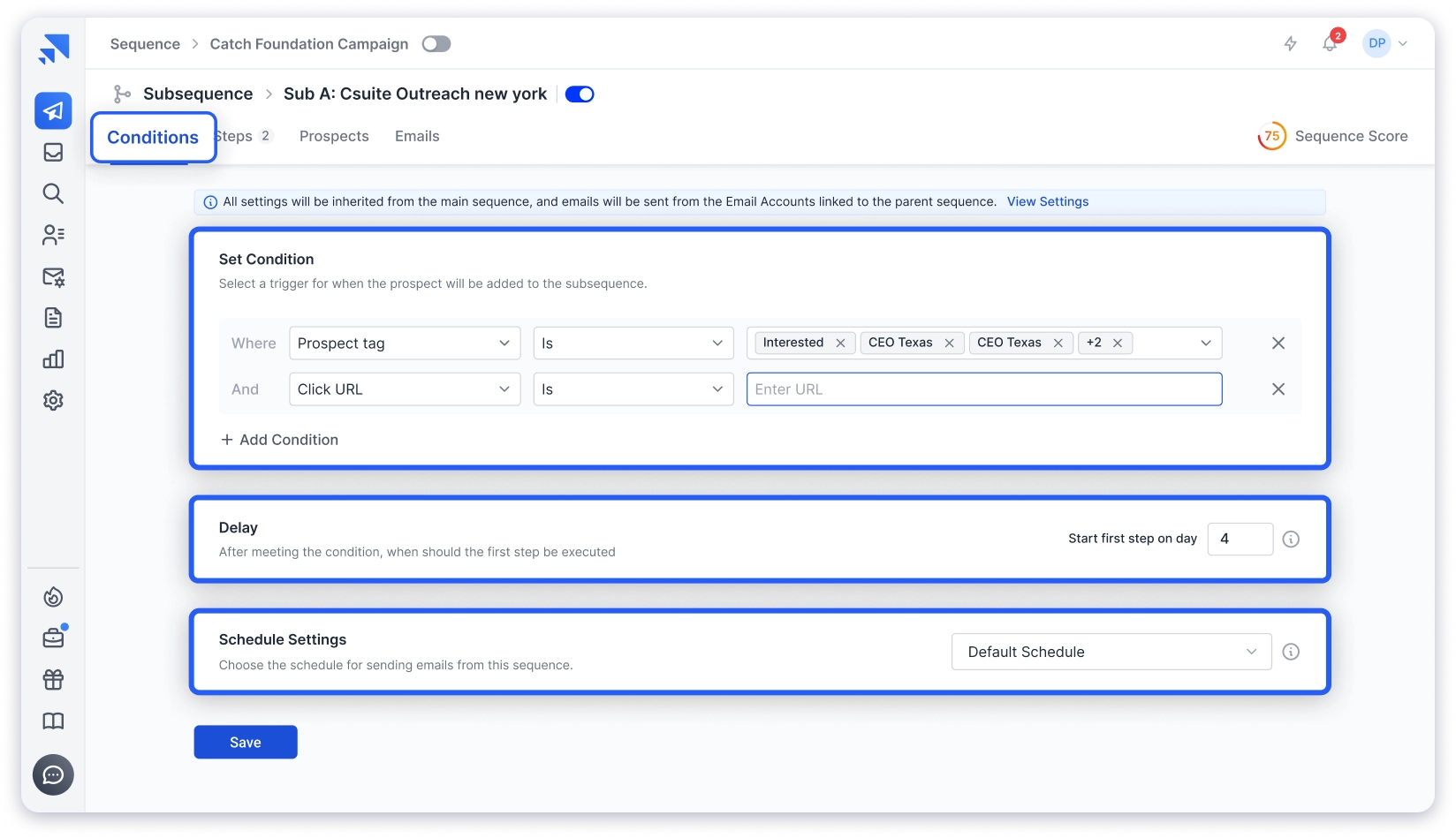
For example, you can set triggers like “if opened”, “If clicked”, “If clicked on the link”, “If not opened”, and send the next email based on the triggers.
2. Real-Time Segmentation with Behavioural Data
This technology groups people based on their actions, such as what they click on websites or which emails they open.
And this all happens in real-time, allowing you to directly add those elements to email sequences.
For example, if someone looks at trainers online, they might get an email about a shoe sale. This makes messages feel personal and helps turn more people into customers.
3. AI Content Writing: Personalised at Scale
AI writing is common, but today we have specific AI variant technologies that function based on the highest cold email standards, ensuring spam-proof copy.
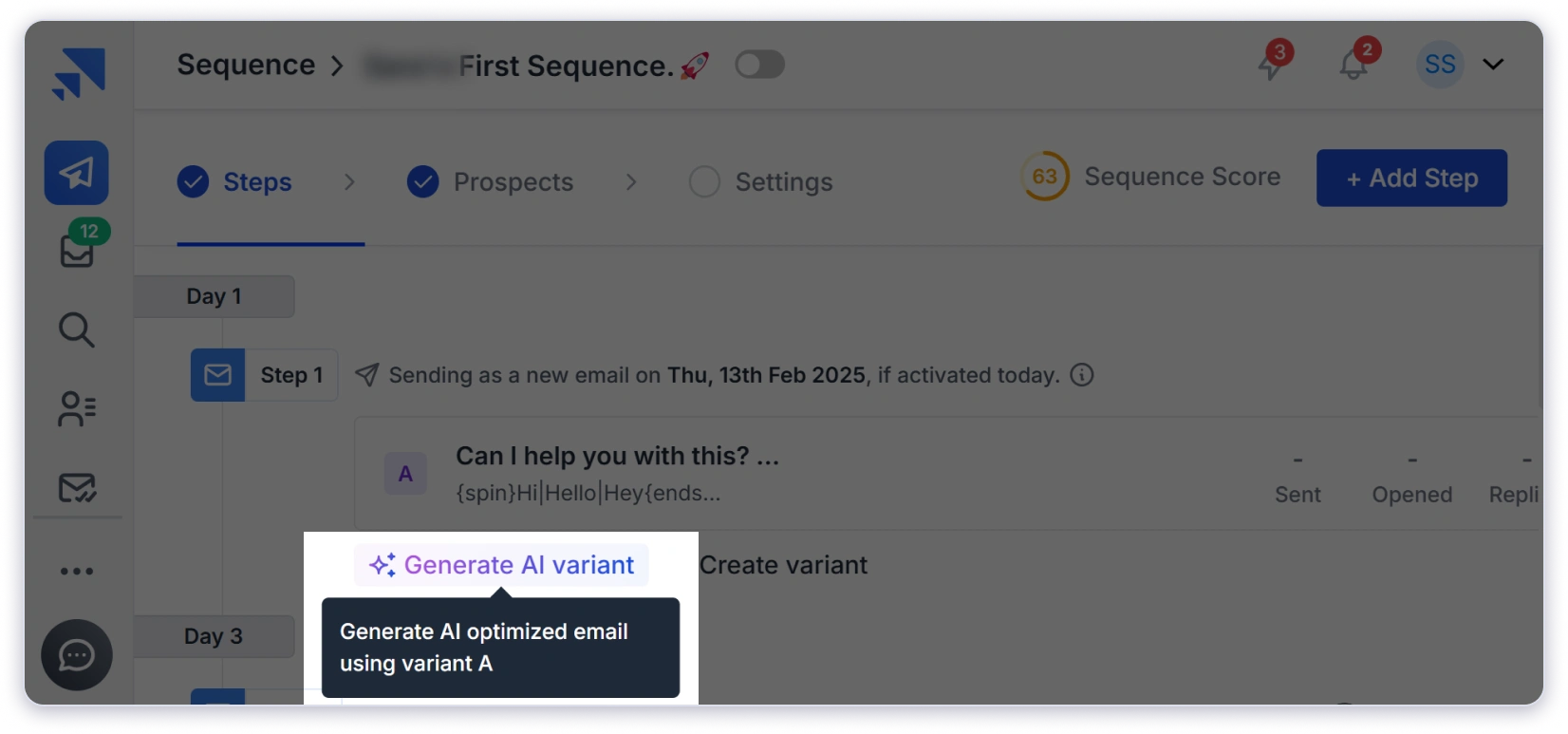
This helps when you are sending at scale but want to maintain deliverability.
Additionally, it helps with A/B testing to determine the type of content that resonates with your audience.
4. Predictive Lead Scoring
This technology scores the leads based on factors such as their job, company size, or past behavior, like downloading a guide.
It is helpful for businesses that receive leads in bulk and need to prioritize with whom to talk first.
Think of it just like picking the ripest apples from a tree to sell at the market.
5. AI Response Categorization
This technology helps businesses that receive numerous responses and want to sort them based on keywords set by them to identify important and positive feedback.
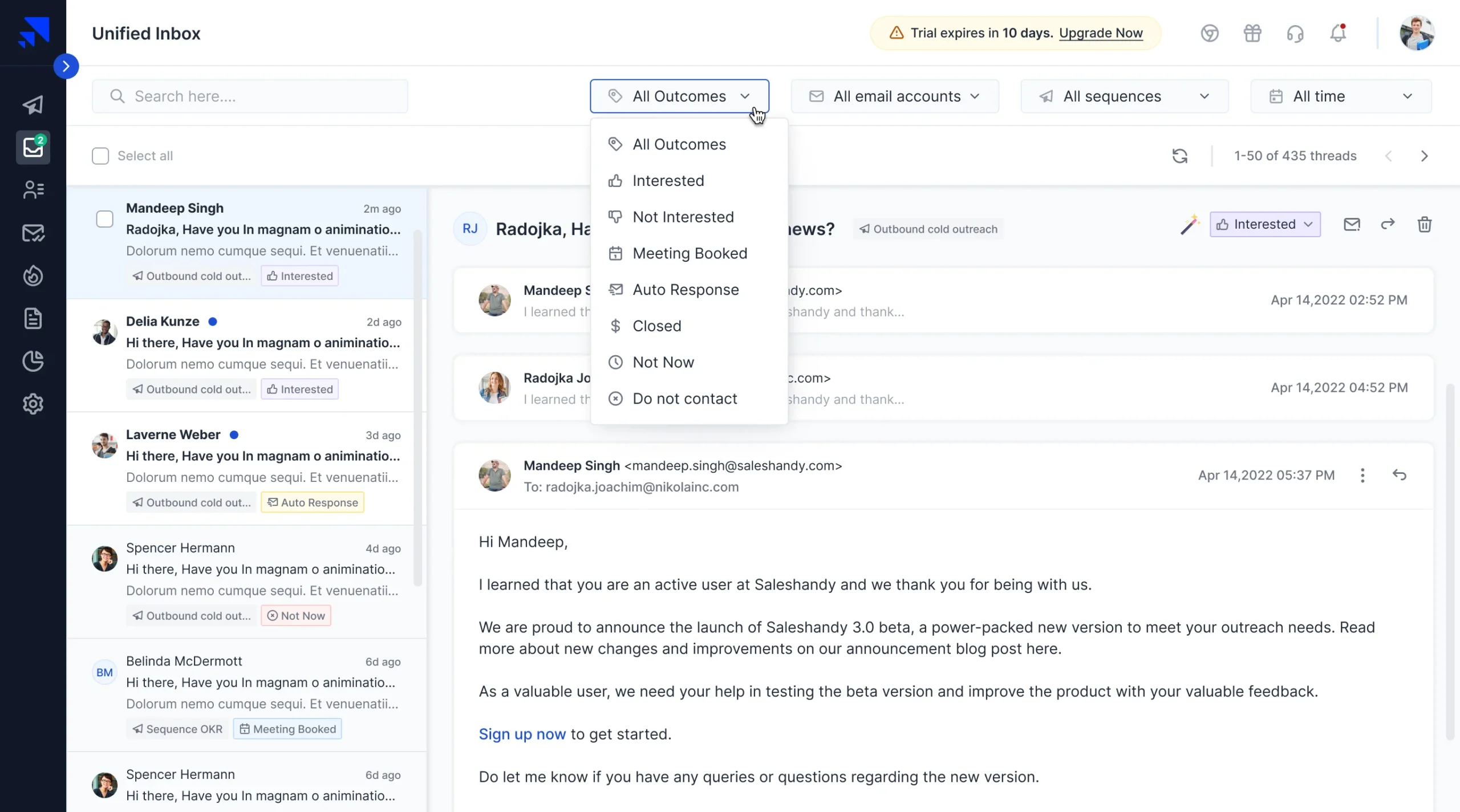
It saves time and also helps in attending to warm leads, converting them into customers.
Key Takeaways
Outbound lead generation isn’t dead, it’s just misunderstood.
When done with precise targeting, the proper outreach channels, and smart automation, outbound becomes a predictable and scalable growth engine.
The strategies shared above aren’t just trends, they’re working systems used by modern sales teams to generate pipeline every single day.
The real edge in 2025? Speed, intent, and personalization. If you’re not using tools that support this, you’re simply working harder than you need to.
I suggest starting with Saleshandy. It brings everything important under one roof: lead finding, hyper-personalised cold emails, automation, tracking, and AI-assisted features.
Additionally, it integrates seamlessly with other channels as needed.
Could not ask for anything better!
FAQs: Outbound Lead Generation
1. What Is Outbound Lead Generation?
Outbound lead generation is the process of proactively reaching out to potential customers through various channels, including cold email, LinkedIn, cold calling, and paid ads. Instead of waiting for leads to come in, your team initiates the conversation.
2. Inbound vs Outbound Lead Gen: Which One Is Better?
It depends on your goals.
- Inbound is slower, but it brings leads who are already interested in your brand.
- Outbound is faster, gives you more control, and works well when you want to target specific accounts or scale outreach quickly.
Most successful businesses use a mix of both.
3. Why Is Outbound Lead Generation Good for Your Brand?
Outbound lead generation puts you in control. Instead of waiting for leads to come to you, you actively reach out to potential customers. This builds brand awareness, accelerates sales, and enables you to target high-value prospects directly, especially useful when launching a new product or expanding into new markets.
4. What are the Key Tasks in an Outbound Lead Gen Campaign?
A successful outbound campaign typically includes:
- Defining your ideal customer profile (ICP)
- Building or buying lead lists
- Writing personalised outreach content
- Choosing the right outreach channels (email, LinkedIn, phone, etc.)
- Launching and tracking the campaign
- Qualifying leads and following up
- Optimising based on performance data
5. What’s the Difference Between Inbound and Outbound Leads?
Inbound leads come to you usually through content, SEO, or ads. They’re often warm but slower to scale.
Outbound leads are people you reach out to directly via cold email, LinkedIn, or calls. It’s faster, gives you control, and works well for targeted B2B sales.
6. Do Outbound Lead Gen Services Work Globally?
Yes, outbound strategies like cold email and LinkedIn outreach are used successfully across the globe.
With tools like Saleshandy, you can reach international leads while maintaining high email deliverability and localized personalization, making global outreach scalable and effective.

